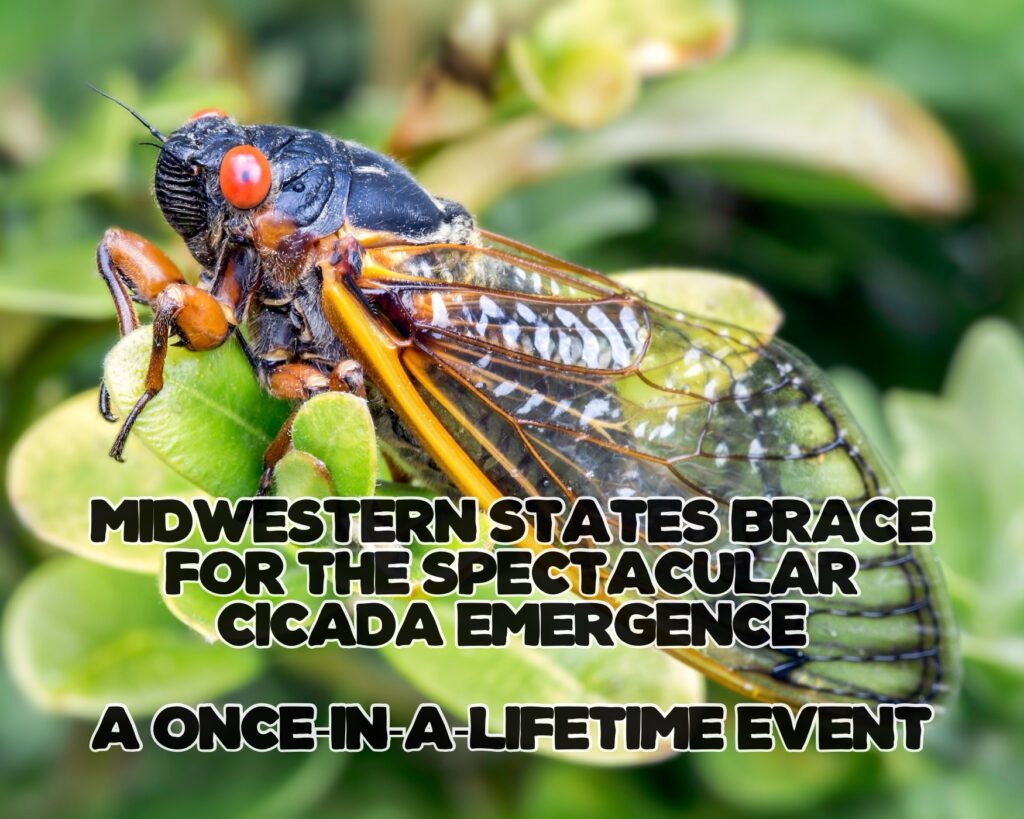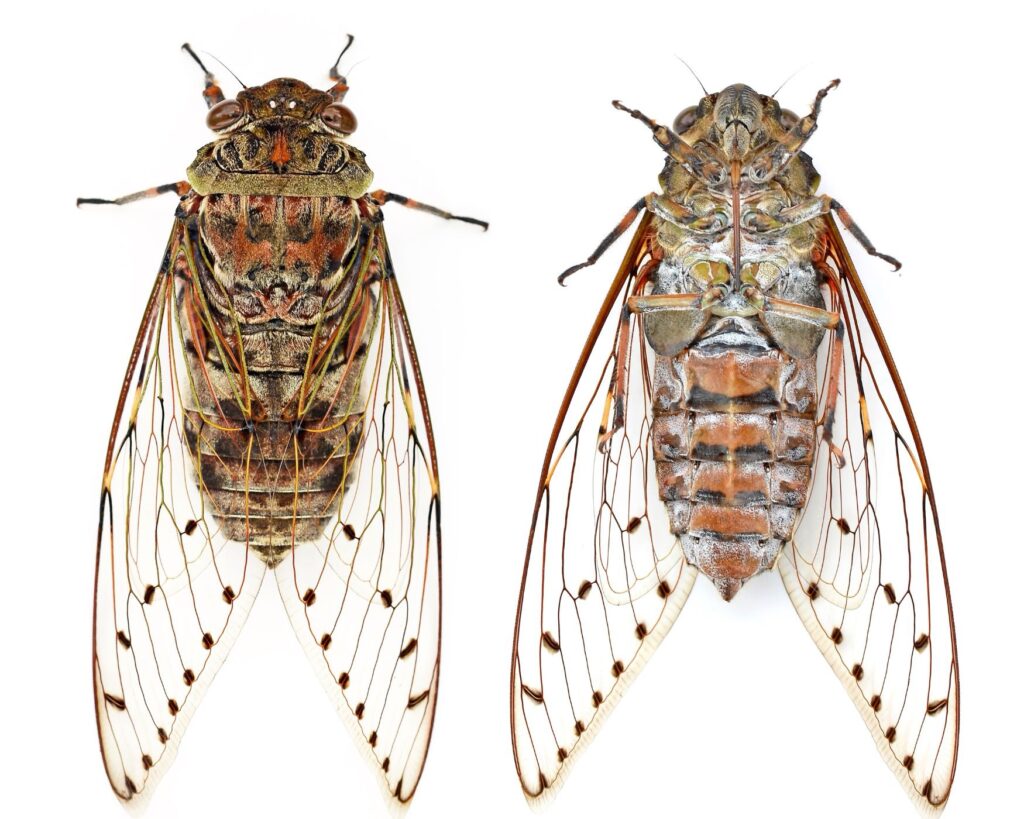Get ready for a natural spectacle like no other! Billions of cicadas are poised to create a buzz this spring in the Midwestern states, as two extraordinary cicada broods are set to emerge simultaneously. What makes this event even more remarkable is that the last time these two broods appeared together was way back in 1803, and they won’t grace us with their presence in unison again for another 221 years. This will happen this year 2024.
Tamra Reall, a University of Missouri Extension specialist, affectionately known as “Dr. Bug,” is eagerly anticipating this entomological extravaganza. She finds the prospect of these two broods emerging together simply exhilarating.

The Marvel of Periodical Cicadas
Periodical cicadas, belonging to the genus Magicicada, are renowned for having the longest life cycle of any insect. These broods, characterized by Roman numerals, emerge synchronously. We are now in for the spectacular convergence of Brood XIII, with its 17-year cycle, and Brood XIX, with a 13-year cycle. This remarkable event marks their first simultaneous appearance since the early 19th century.
To put this in historical perspective, the last joint emergence of these broods occurred during Thomas Jefferson’s presidency, which predates Missouri’s statehood. If you’re wondering when you’ll get to see this phenomenon again, the next such event is projected to happen in the year 2245.
A Midwest Cicada Extravaganza
Cicada enthusiasts in 18 Midwestern states are in for a treat. Missourians will primarily witness Brood XIX, also known as the Great Southern Brood, which last graced the state with its presence in 2011. The emergence of these fascinating insects is expected from late April to early May.
Residents near the Illinois border in northeastern Missouri might have the unique experience of witnessing both broods making their appearance.
The Epic Cicada Lifecycle
Cicada nymphs, after spending 13 or 17 years underground, emerge when soil temperatures reach 64 degrees Fahrenheit. Their emergence strategy is simple but effective: they come out in massive numbers. After ascending trees or other vertical structures and shedding their exoskeletons, they commence the mating ritual. The entire lifecycle, from emergence to their inevitable demise, spans a mere four to six weeks.
With the potential of reaching staggering numbers, up to 1.5 million cicadas per acre, after spring rains, these little creatures will undoubtedly attract numerous predators and may result in a significant amount of litter.
Brood XIX and Beyond
Brood XIX, consisting of four species, will also make appearances in several other states, including Alabama, Arkansas, and Georgia, from late April through mid-May.
Meanwhile, Brood XIII, known as the Northern Illinois Brood and comprising three species, is expected in Iowa, Illinois, Indiana, Wisconsin, and possibly Michigan in 2024. Stragglers from this brood may even extend to southern Illinois and St. Louis. Their emergence is anticipated from mid-May through June.
The Cicada Symphony
The loud, collective sounds heard during cicada emergence are the result of male mating calls, which can be as deafening as lawnmowers. Each species of cicada has its distinct call, and when they synchronize, the sound they produce can even surpass that of a jet engine.
With five eyes, cicadas are vigilant when it comes to seeking mates. Their brief adult life, spanning only four to six weeks, is wholly dedicated to reproduction. After their mating mission is complete, the males meet their fate.

The Life Cycle Continues
Female cicadas play their part by laying eggs in tree branches before they too meet their end. The eggs subsequently fall to the ground, where the nymphs burrow into the soil and begin the cycle anew.
Despite being loud and potentially messy, cicadas pose no harm to humans or pets. Tamra Reall advises against using pesticides, as they can harm birds and other beneficial insects. Instead, she suggests protecting new trees and bushes with cheesecloth.
Be Part of the Cicada Safari
Missourians and cicada enthusiasts everywhere are encouraged to participate in mapping the cicada emergence by using the Cicada Safari app, available on the Cicada Safari website. This initiative is led by the eminent entomologist Gene Kritsky, providing an exciting opportunity for people to contribute to the study of this extraordinary natural phenomenon.
So, gear up for the sensational cicada emergence, an event that won’t repeat itself for over two centuries. It’s a testament to the remarkable wonders of nature, reminding us of the beauty and complexity of the world we share with these fascinating insects.
The Ecological Significance
While the massive cicada emergence may seem like a noisy inconvenience to some, it’s essential to recognize the ecological significance of this phenomenon. Cicadas play a vital role in the ecosystem, and their appearance has ripple effects throughout the natural world.
Natural Pruning
One of the key ecological roles of cicadas is what entomologists refer to as “natural pruning.” When cicadas lay their eggs in tree branches, the process can lead to the trimming of small branches and twigs. While this may seem destructive, it’s a natural way of thinning out tree canopies, allowing sunlight to reach the forest floor. This, in turn, promotes the growth of new plants and contributes to the overall health of the forest ecosystem.
Nutrient Cycling
Cicadas don’t just emerge to create a cacophony; they also play a crucial role in nutrient cycling. When cicadas die, their bodies decompose and return essential nutrients to the soil. These nutrients, such as nitrogen, become available to plants, supporting their growth. In this way, cicadas contribute to the health and vitality of the forests they inhabit.
Food Source for Wildlife
The emergence of cicadas provides a bountiful food source for a variety of wildlife species. Birds, squirrels, and other animals feast on these protein-rich insects during their brief time above ground. This sudden abundance of food can boost the reproductive success of these animals and contribute to the overall balance of the ecosystem.
Scientific Research Opportunities
Cicada emergences also offer valuable opportunities for scientific research. Entomologists and ecologists seize the chance to study the behavior, genetics, and ecological impact of these insects. The data collected during these events can provide insights into broader ecological processes and help us better understand the intricate web of life in our natural world.
The Cicada Safari Initiative
As previously mentioned, you can actively participate in documenting this extraordinary natural event through the Cicada Safari app. This initiative, led by the esteemed entomologist Gene Kritsky, empowers citizen scientists and enthusiasts alike to contribute valuable observations and data to the study of cicadas.
By participating in the Cicada Safari, you not only get to be part of a scientific endeavor but also gain a deeper appreciation for the wonders of the natural world. It’s a chance to connect with nature and contribute to our understanding of these fascinating insects.
Get Ready To Embrace the Cicada Symphony 2024
As the Midwestern states brace for the massive cicada emergence, it’s a reminder of the awe-inspiring beauty and complexity of the natural world. While the loud sounds and temporary inconveniences may grab our attention, it’s crucial to recognize the ecological importance of this event.
Cicadas, with their lengthy life cycles and synchronized emergences, are a testament to the intricate balance of nature. They prune trees, recycle nutrients, and provide sustenance to countless creatures. Moreover, they offer a unique opportunity for scientific discovery and citizen engagement in the study of our environment.
So, as you witness the symphony of cicadas this spring, take a moment to appreciate the grandeur of nature’s cycles. Be part of the Cicada Safari if you can and contribute to our collective understanding of these incredible insects. After all, the next time these two broods emerge together won’t be for another 221 years, making this a truly once-in-a-lifetime event.
As an Amazon Associate we earn from qualifying purchases through some links in our articles.




